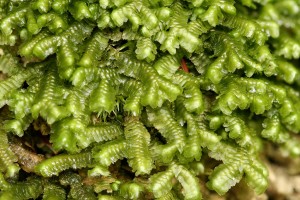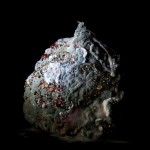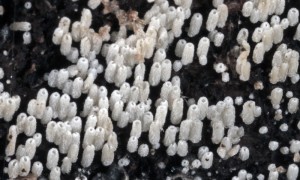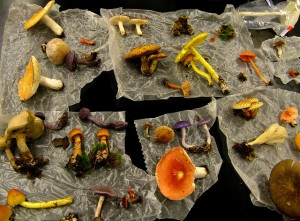Here, at last, is a bog posting set in a bog — specifically, Chickering Bog in Calais, Vermont. Like many so-called bogs, it’s really an intermediate fen, which means that it’s not isolated from ground water like actual bogs are.
Recently, I visited Chickering with my friend Charles Johnson, author of Bogs of the Northeast, and his naturalist wife Nona. As we strolled past buckthorn, golden saxifrage, and bog rosemary, I asked Charles how he became interested in bogs. Nona answered for him, saying, “But how can a person not be interested in bogs?”
Soon we were surrounded by pitcher plants, and I bent down and sniffed one. Ah, what a sweet perfumey smell! People who’ve never sniffed a pitcher plant have no idea what they’re missing.“While humans are a threat to bogs, maybe a bigger threat is dogs,” observed Charles. “They jump in, splash around, and drive out the small amount of oxygen that exists in a bog’s upper layer.”
“That’s why I prefer dogs in satay sauce rather than in a bog,” I said, citing one of my previous bog postings.
Charles and Nona, who loved dogs, understood. A bog (or even an intermediate fen) is a sacred place and should not be defiled.
I needed to answer nature’s call, and rather than defile Chickering with my uric acid, I ventured back into the woods. All at once, in a grove of hemlock, I saw a trilobite! Ancient though it was, the trilobite seemed no less alive than I was. Likewise, it had the distinct odor of sandalwood.
I delighted in the trilobite’s small teeth at the tip of each leaf. I delighted in the way the leaves overlapped each other like shingles on a roof. I even delighted in its resemblance to a millipede, so much so that in some place it’s been called “the millipede weed.”
Okay, I’m being a bit disingenuous here. What I saw was not a marine arthropod, but the liverwort Bazzania trilobata, and I somehow didn’t think “A Living Trilobata” has very much caché as the title for a bog posting. Still, Bazzania trilobata and trilobites are not altogether unlike each other. For liverworts are among the most primitive of all plants, perhaps even the most primitive, and their ancestors were almost contemporaneous with trilobites.
What’s the moral of this little tale? Heed nature’s call, and nature herself might come calling…
thanks to Bob Klips, a fellow admirer of wee green things, for kind permission to use his photo.





 If a sled dog in Greenland has outlived its usefulness, it can be useful again, as cuisine. In fact, the first dog I ever ate was a former Greenland sled dog. The hunter who offered it to me suggested that it was not nearly as good as seal. I had to agree. The meat was tough, stringy, and extremely greasy. It tasted not unlike the way a wet dog smells. Note: As the custom of using sled dogs declines in Greenland, so does the custom of eating them.
If a sled dog in Greenland has outlived its usefulness, it can be useful again, as cuisine. In fact, the first dog I ever ate was a former Greenland sled dog. The hunter who offered it to me suggested that it was not nearly as good as seal. I had to agree. The meat was tough, stringy, and extremely greasy. It tasted not unlike the way a wet dog smells. Note: As the custom of using sled dogs declines in Greenland, so does the custom of eating them.